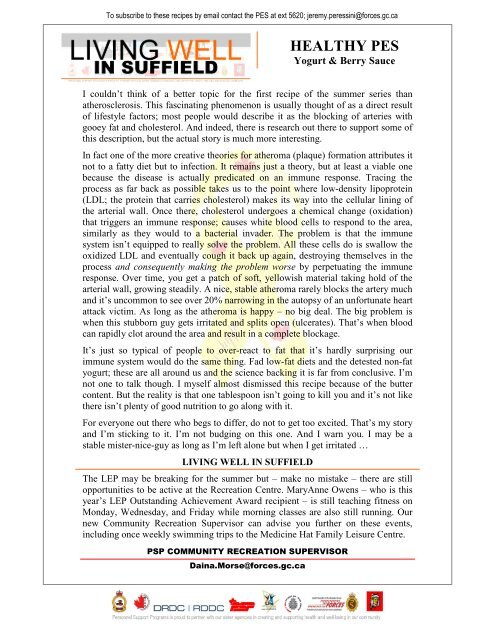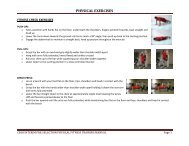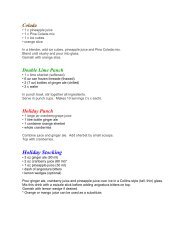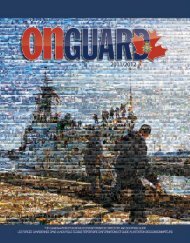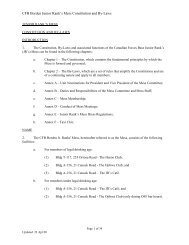12 July 13 - Yogurt & Berry Sauce
12 July 13 - Yogurt & Berry Sauce
12 July 13 - Yogurt & Berry Sauce
You also want an ePaper? Increase the reach of your titles
YUMPU automatically turns print PDFs into web optimized ePapers that Google loves.
To subscribe to these recipes by email contact the PES at ext 5620; jeremy.peressini@forces.gc.ca<br />
HEALTHY PES<br />
<strong>Yogurt</strong> & <strong>Berry</strong> <strong>Sauce</strong><br />
I couldn’t think of a better topic for the first recipe of the summer series than<br />
atherosclerosis. This fascinating phenomenon is usually thought of as a direct result<br />
of lifestyle factors; most people would describe it as the blocking of arteries with<br />
gooey fat and cholesterol. And indeed, there is research out there to support some of<br />
this description, but the actual story is much more interesting.<br />
In fact one of the more creative theories for atheroma (plaque) formation attributes it<br />
not to a fatty diet but to infection. It remains just a theory, but at least a viable one<br />
because the disease is actually predicated on an immune response. Tracing the<br />
process as far back as possible takes us to the point where low-density lipoprotein<br />
(LDL; the protein that carries cholesterol) makes its way into the cellular lining of<br />
the arterial wall. Once there, cholesterol undergoes a chemical change (oxidation)<br />
that triggers an immune response; causes white blood cells to respond to the area,<br />
similarly as they would to a bacterial invader. The problem is that the immune<br />
system isn’t equipped to really solve the problem. All these cells do is swallow the<br />
oxidized LDL and eventually cough it back up again, destroying themselves in the<br />
process and consequently making the problem worse by perpetuating the immune<br />
response. Over time, you get a patch of soft, yellowish material taking hold of the<br />
arterial wall, growing steadily. A nice, stable atheroma rarely blocks the artery much<br />
and it’s uncommon to see over 20% narrowing in the autopsy of an unfortunate heart<br />
attack victim. As long as the atheroma is happy – no big deal. The big problem is<br />
when this stubborn guy gets irritated and splits open (ulcerates). That’s when blood<br />
can rapidly clot around the area and result in a complete blockage.<br />
It’s just so typical of people to over-react to fat that it’s hardly surprising our<br />
immune system would do the same thing. Fad low-fat diets and the detested non-fat<br />
yogurt; these are all around us and the science backing it is far from conclusive. I’m<br />
not one to talk though. I myself almost dismissed this recipe because of the butter<br />
content. But the reality is that one tablespoon isn’t going to kill you and it’s not like<br />
there isn’t plenty of good nutrition to go along with it.<br />
For everyone out there who begs to differ, do not to get too excited. That’s my story<br />
and I’m sticking to it. I’m not budging on this one. And I warn you. I may be a<br />
stable mister-nice-guy as long as I’m left alone but when I get irritated …<br />
LIVING WELL IN SUFFIELD<br />
The LEP may be breaking for the summer but – make no mistake – there are still<br />
opportunities to be active at the Recreation Centre. MaryAnne Owens – who is this<br />
year’s LEP Outstanding Achievement Award recipient – is still teaching fitness on<br />
Monday, Wednesday, and Friday while morning classes are also still running. Our<br />
new Community Recreation Supervisor can advise you further on these events,<br />
including once weekly swimming trips to the Medicine Hat Family Leisure Centre.<br />
PSP COMMUNITY RECREATION SUPERVISOR<br />
Daina.Morse@forces.gc.ca
To subscribe to these recipes by email contact the PES at ext 5620; jeremy.peressini@forces.gc.ca<br />
DIRECTIONS<br />
For best results, chill yogurt in freezer for ~ one hour or until hardening starts to set<br />
in (careful not to freeze solid). Combine berries with water, sugar, and lemon juice<br />
in a small saucepan. Bring this to a low boil and maintain on low heat for ~ ten<br />
minutes. Once sauce is thickened, stir in butter. Next, pour yogurt into four equally<br />
sized servings, topping each with one-quarter of the sauce and serve promptly.<br />
INGREDIENTS<br />
frozen blueberry; ⅔ cup<br />
frozen blackberry; ⅔ cup<br />
water; ½ cup<br />
sugar; ¼ cup<br />
lemon juice; 2 tbsp<br />
butter; 1 tbsp<br />
greek yogurt – plain (2%); 2 cups<br />
SPOTLIGHT ON NUTRITION<br />
As you would expect from a darkly-coloured fruit, the blackberry is a rich source of<br />
antioxidants, including anthocyanins. In fact, it’s the number-one fruit overall when<br />
it comes to broad spectrum antioxidant content. To get an idea of the antiinflammatory<br />
benefits, take capillaries as a case in point. Capillary connective tissue<br />
is routinely damaged as part of the regular inflammatory response to stress. As a<br />
result of consequent haemorrhage, oxidant damage to surrounding tissue is known to<br />
result. Not only does anthocyanin help to prevent and reduce capillary destruction in<br />
the first place, it also helps combat resultant oxidative damage. In larger blood<br />
vessels – arteries – this property of anthocyanin is even more important in the fight<br />
against a major killer: Atherosclerosis. It’s not generally known that atherosclerosis<br />
(the main basis for chronic heart disease) is actually based in an immune response;<br />
one that starts on the wall of the artery with the oxidation of low-density lipoprotein<br />
(LDL). The cascade of events occurring after eventually leads to the formation of<br />
plaque which not only narrows the diameter (lumen) of the vessel, it is also at risk of<br />
ulceration. If an ulcer forms, further blood clotting at the site can occur and lead to<br />
obstruction of blood flow and (if in a coronary artery) heart attack. What<br />
anthocyanin has been shown to do is reduce the event that kicks off the process:<br />
LDL oxidation in addition. It also has been shown to increase the integrity of the<br />
arterial endothelial lining which is important in the prevention of the immune<br />
response that irritates formed atheroma and can trigger catastrophic clotting. Much<br />
of the same nutritional profile is present in the blackberry, which also has the benefit<br />
of being exceptionally low on the glycemic index with consequent blood sugar<br />
benefits. In each of the four servings in one batch of this recipe you may expect as<br />
much as <strong>12</strong> g of protein, 6 g fat along with 192 kcal<br />
HEALTHY PES SUPER FOODS<br />
Cauliflower, Broccoli, Extra-Virgin Olive Oil, Oats, Yams, Lentils<br />
Quinoa, Salmon, Blueberries, Black & Kidney Beans, <strong>Yogurt</strong><br />
Pinto Beans, Flax Seed, Walnuts, Eggs, Almonds


